|
|
|
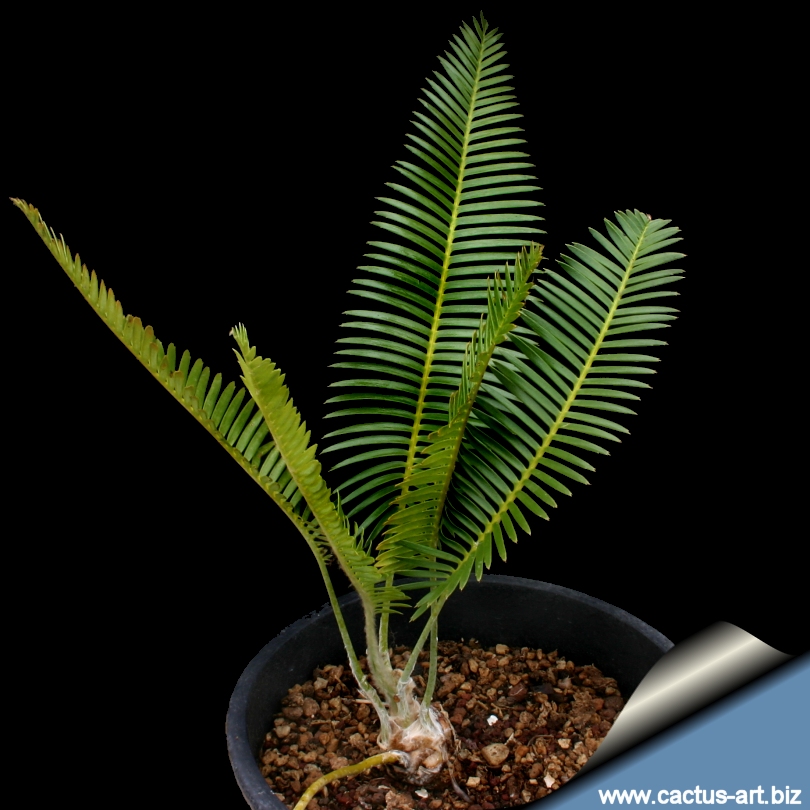
Dioon edule (a 10 years old seedling!)
They are extremely slow growing to our eyes but we must
understand that they have been around for over 200 million years
(remember these plants were around during the time of dinosaurs). Notice
their distinctive character which reflects their antiquity and some very
large specimens could possibly be several hundred years old. They truly
are unequalled and intriguing living organisms that count the eons of
time while we count the seconds. They are beauties.
|
|
Description: It is a woody
dioecious, plant that superficially resemble a palm or a tree fern.
Stem: The trunk is usually unbranched or sparsely branched,
palm-like and may reach 4 m of height under optimal conditions (Usually
less), 20-50 cm diameter.
Leaves: Produces 15 to 150 leathery, featherlike (pinnate)
leaves. They are spirally arranged in a cluster that extend radially at
the summit of the stem, they are stiff, upright, light or bright green
or blue or blue-green, semi-glossy to dull, 100-200 cm long, flat (not
keeled) in section (opposing leaflets inserted at 180° on rachis), with
70-150 leaflets tappering to a sharp point; basal leaflets reducing to
spines, petiole spine-free for 5 cm. They resemble futuristic radio
antennae and are retained for some number of years.
Leaflets narrowly lanceolate,
concolorous, not falcate, inserted at 90°
to rachis, not overlapping; margins flat, entire; median leaflets 6-12
cm long, 5-10 mm wide.
Male Flowers: Pollen cones ovoid to fusiform, pale brown, 15-40
cm long, 6-10 cm diam. Microsporophyll apex 30 mm long, 20 mm wide.
Female cones: Seed cones ovoid, pale grey, 20-35 cm long, 12-20
cm diam. Megasporophyll apex 35 mm long, 25 mm wide.
Fruit: The seed cones entirely resemble those of truly coniferous
genus Araucaria or a pineapple in form but the scales are feather-like
and soft to the touch. A mature female cone may weigh 1-2 kg and contain
up to 200 or more seeds. Eventually the cone unravels to reveal nut
sized seeds with a thin leathery skin.
Seeds: Ovoid, cream or white, 25-45 mm long, 20-30 mm wide, they
take more than a year to mature.
|
|
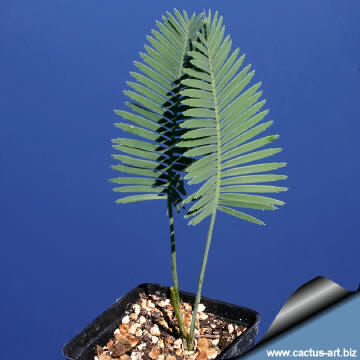
Two years old seedling.
|
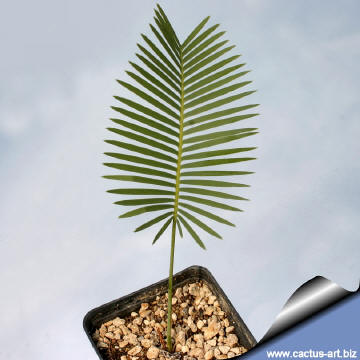
Dioon edule (Santa Rita, Mexico)
|
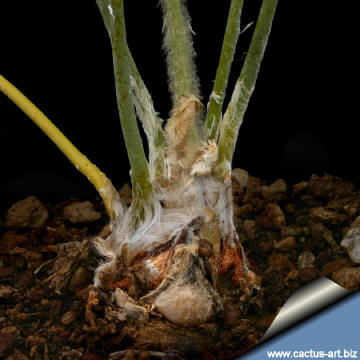 |
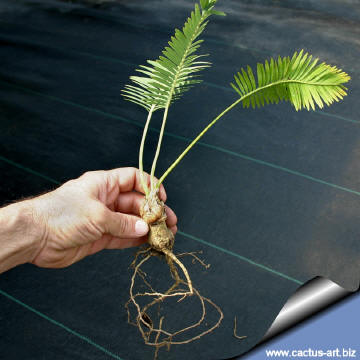 |
|

 |
|
WARNING: The leaflets of dioon taper to a sharp point. It is well
advised to plant virgin's palm away from footpaths and walkways. Wear
heavy gloves when handling or working close to the virgin's palm to
avoid getting jabbed by the sharp points of the leaflets.
Advertising
|
|
|
|
|
|
|
Family: Zamiaceae
Scientific name: Dion
edule J. Lindley
In: Edward's Bot. Reg. 29: misc. 59-60 (1843).
Type Specimen: cult., from Mexico, Lindley s.n. (holo CGE).
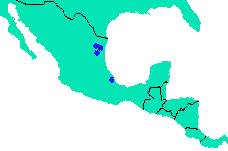 Origin:
Eastern coast of Mexico (Nuevo Leon, San Luis, Tamaulipas (var.
angustifolium) Origin:
Eastern coast of Mexico (Nuevo Leon, San Luis, Tamaulipas (var.
angustifolium)
Habitat and ecology:
They grows in tropical deciduous oak forests, and in harsh, dry
conditions in steep hillsides on extremely steep slopes where the soils
are skeletal and poor with few nutrients, in limestone, serpentine or in
sandy soil, but they can also be found in more hospitable soils and
shelter. Interestingly, Dioon edule specifically has the ability to
contract its stem underground as it grows — thus maintaining relativity
in the amount of trunk exposed. One suggested explanation for this
strange (unplant-like) activity is to reduce its exposure to
environmental stress and predation —. Also, they may go through
prolonged periods of rest, revealed as narrowing in the diameter of the
trunk.
Conservation status: Listed in
CITES appendix 2.
Common Names include: Virgin's palm, Chestnut Dioon
Etymology: The genus name Dioon
comes from the Greek, meaning "two egg", because the seeds are
produced in pairs. The species name edule is derived from
the Latin, meaning "edible".
Synonyms:
- Dioon aculeatum Lem.
Ill. Hort. 2. Misc. 92 (1855).
- Dioon imbricatum Miq.,
Tijdschr. Wis-Natuurk. Wetensch. Eerste Kl. Kon.
Ned. Inst. Wetensch. 1: 36 (1848).
- Dioon edule f. imbricatum (Miq.)
Miq.,
Arch. Néerl. Sci. Exact. Nat. 3: 427 (1868).
- Dioon strobilosum Lem.
Ill. Hort. 10: Misc. 4. (1863).
- Dioon strobilaceum Lem. ex DC.
Ill. Hort. 10: Misc. 4. (1863).
- Macrozamia littoralis Liebm. ex
Dyer
in Hemsl., Biol. Cent.-Amer., Bot. 3: ? (1884).
- Macrozamia pectinata Liebm. ex
Dyer
in Hemsl., Biol. Cent.-Amer., Bot. 3: ? (1884).
- Zamia maeleni Miq.
Linnaea 18: 97 (1844).
- Zamia friderici-guilielmi hort.
Parment. ex Miq.
Prodr. Syst. Cycad.: 22 (1861), nom. nud.
- Zamia macleani Regel
Gartenflora 25: 371 (1876), nom. nud.
- Zamia rigida Karw. ex J. Schust.
in Engl., Pflanzenr. 4(1): 125 (1932), nom. nud.
|
|
|
|
There are several varieties of Dioon edule, and some put these
varieties in different species categories. Most all look about the same
except for minor variations in the leaf pattern of which two subspecies
are currently accepted
• Dioon edule subsp. angustifolium
• Dioon edule subsp. edule
The giant dioon (Dioon spinulosum) is similar but
larger in stature and less cold hardy.
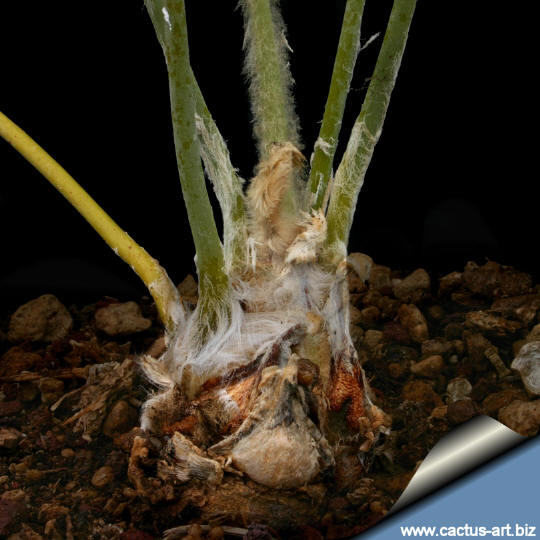
Cultivation: They are very adaptable plants to just about any
soil except muddy, non-draining clay. They are long lived and slow
growing and a plant with 30cm of stem can be quite old (20-40 or more
years). They prefer well drained, gritty soil with plenty of water,
especially in dry weather. Naturally undemanding for nutrients, they
responds very well to regular applications of fertilizer. Growth can be
greatly improved through the application of fertilizers. Most growers
find that a fertilizer having an even NPK (Nitrogen, Phosphorus,
Potassium) balance, and supplemental trace elements, provides a good
start for cycads. They thrives and grows best in partial shade. In
cultivation prefers moist soil with good drainage for optimal growth.
But they are eventually very drought resistant. Mature and established
plants have been reported to tolerate temperatures down to -12ºC for
some days.
Dioon edule is one of the most cold hardy cycads.
Propagation: Virgin's palm may be propagated by seeds or by
division and replanting of the attractive offsets or "pups" formed at
the base of the oldest plant. They are among the easiest plants to
germinate. The seeds are about a large grape size and hard as a rock.
USES: The Indians of the region of origin have used the pulp of the seed as
a source of flour (The young seeds are ground and cooked into tortillas)
and also the stem of this plant contains abundance of starch, which may
be extracted and used as arrow-root. We know little of the precautions
used to prepare them for consumption, but since the skin of the seeds is
reportedly carcinogenic we strongly advise the use of gloves when
handling the seeds and caution against eating any parts of any cycad!
The leaves (fronds) of virgin's palm are used for decoration, especially
in religious ceremonies.
|
|







